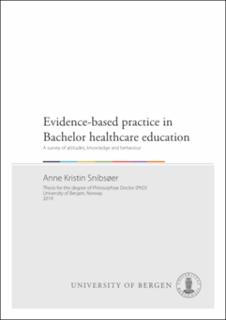| dc.contributor.author | Snibsøer, Anne Kristin | en_US |
| dc.date.accessioned | 2019-07-02T09:38:27Z | |
| dc.date.available | 2019-07-02T09:38:27Z | |
| dc.date.issued | 2019-06-11 | |
| dc.identifier.isbn | 9788230854211 | en_US |
| dc.identifier.uri | https://hdl.handle.net/1956/20539 | |
| dc.description.abstract | Background: Educational programmes in healthcare are expected to integrate evidence-based practice (EBP) into their curricula to ensure that Bachelor students have the requisite EBP attitudes, knowledge and behaviour when they graduate. To assess EBP profiles, instruments with evaluated measurement properties should be used. Few studies have explored EBP profiles among Bachelor students across health disciplines and educational institutions, and research is needed to enhance the understanding of EBP teaching and learning at the Bachelor level. Aim: The overall aim of this PhD project was to contribute to the understanding of measurement and outcomes of EBP learning among healthcare students at the Bachelor level. Methods: Three studies with two different designs were conducted. Paper 1: The Evidence-Based Practice Profile (EBP2) questionnaire was translated and the measurement properties of the Norwegian version (EBP2-N) evaluated among Bachelor students and healthcare professionals. We performed forward-backward translation and evaluated measurement properties related to reliability, validity and responsiveness. Paper 2: We applied the EBP2-N and surveyed final year Bachelor students in nursing, occupational therapy, physiotherapy and radiography from four educational institutions in Norway. We performed regression analyses to analyze differences in mean EBP2-N domain (Relevance, Terminology, Confidence, Practice and Sympathy) scores between health disciplines, Cohen’s d to illustrate the magnitude of the largest differences, and Spearman’s rho (rs) to assess the monotonic relationship between EBP2-N domains and students’ assessment of EBP teaching and expectations of EBP performance, respectively. Paper 3: In this survey, we invited Norwegian and Canadian students to answer the EBP2 Terminology domain items (self-reported), an additional item of ‘evidence-based practice’ and six random openended questions (objective) corresponding to the domain items. We used weighted kappa (Kw) to investigate inter-rater agreement between self-reported and objective items, and intraclass correlation coefficient (ICC) to estimate overall agreement. Results: Paper 1: The forward–backward translation was repeated three times. Adequate reliability and discriminative validity were found for three of the five EBP2- N domains (Relevance, Terminology and Confidence). The confirmatory factor analysis did not indicate a five-factor model fit. Responsiveness was as expected or better for all domains, except Sympathy. Paper 2: The highest overall mean score was found for Relevance, with an estimated standardized mean of 81.2 (CI 95% = 80.4– 82.0). Standardized means were 54 and less for the other EBP2–N domains. Differences between health disciplines were found for all domains (p < 0.03), and between educational institutions for three domains (Relevance, Terminology, Sympathy). We observed positive associations between Relevance and students’ assessment of EBP teaching (rs = 0.31), and expectations of EBP performance from teachers (rs = 0.36); and between Confidence and students’ assessment of EBP teaching (rs = 0.46). Paper 3: For all research terms, mean self-reported scores were higher than objectively assessed scores (p < 0.001). Agreement between self-reported and objectively assessed open-ended items varied (Kw = 0.04 to Kw = 0.69). The overall agreement for the EBP2 Terminology domain was poor (ICC = 0.29). Conclusions: The EBP2-N was valid and reliable for the domains of Relevance, Terminology and Confidence, and responsive to change for all domains, except Sympathy. Bachelor students found EBP relevant, but reported limited understanding of EBP terminology, limited confidence with EBP skills, and infrequent use of EBP. We found that there were statistically significant, but small differences between health disciplines for all EBP2-N domains, and between educational institutions for three domains. There was overall low agreement between students' self-reported and objectively assessed knowledge of EBP terminology. Before further use of the EBP2- N, adequate structural validity and reliability should be enhanced for all EBP2-N domains. For the purpose of educational assessment, users should be aware that selfratings on the Terminology domain would be higher than objectively assessed knowledge. Efforts are needed to further develop the understanding of EBP and to explore strategies for enhancing EBP in curricula and in teaching across Bachelor programmes in healthcare. | en_US |
| dc.language.iso | eng | eng |
| dc.publisher | The University of Bergen | eng |
| dc.relation.haspart | Paper I: Titlestad KB, Snibsoer AK, Stromme H, Nortvedt MW, Graverholt B, Espehaug B. Translation, cross-cultural adaption and measurement properties of the evidence-based practice profile. BMC Res Notes 2017;10(1):44. The article is available at: <a href="http://hdl.handle.net/1956/20538" target="blank">http://hdl.handle.net/1956/20538</a> | en_US |
| dc.relation.haspart | Paper II: Snibsøer AK, Graverholt B, Nortvedt MW, Riise T, Espehaug B. Evidence-based practice profiles among Bachelor students in four health disciplines: a cross-sectional study. BMC Medical Education 2018;18(1):210. The article is available at: <a href="http://hdl.handle.net/1956/19350" target="blank">http://hdl.handle.net/1956/19350</a> | en_US |
| dc.relation.haspart | Paper III: Snibsoer AK, Ciliska D, Yost J, Graverholt B, Nortvedt MW, Riise T, Espehaug B. Self-reported and objectively assessed knowledge of evidence-based practice terminology among healthcare students: a crosssectional study. PLoS One. 2018;13(7):e0200313. The article is available at: <a href="http://hdl.handle.net/1956/19319" target="blank">http://hdl.handle.net/1956/19319</a> | en_US |
| dc.title | Evidence-based practice in Bachelor healthcare education. A survey of attitudes, knowledge and behaviour | en_US |
| dc.type | Doctoral thesis | |
| dc.rights.holder | Copyright the author. All rights reserved | |
| dc.identifier.cristin | 1705364 | |
